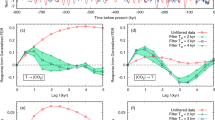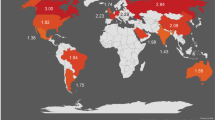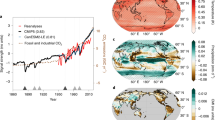Abstract
The statistical association between temperature and greenhouse gases over glacial cycles is well documented1, but causality behind this correlation remains difficult to extract directly from the data. A time lag of CO2 behind Antarctic temperature—originally thought to hint at a driving role for temperature2,3—is absent4,5 at the last deglaciation, but recently confirmed at the last ice age inception6 and the end of the earlier termination II (ref. 7). We show that such variable time lags are typical for complex nonlinear systems such as the climate, prohibiting straightforward use of correlation lags to infer causation. However, an insight from dynamical systems theory8 now allows us to circumvent the classical challenges of unravelling causation from multivariate time series. We build on this insight to demonstrate directly from ice-core data that, over glacial–interglacial timescales, climate dynamics are largely driven by internal Earth system mechanisms, including a marked positive feedback effect from temperature variability on greenhouse-gas concentrations.
This is a preview of subscription content, access via your institution
Access options
Subscribe to this journal
Receive 12 print issues and online access
$209.00 per year
only $17.42 per issue
Buy this article
- Purchase on Springer Link
- Instant access to full article PDF
Prices may be subject to local taxes which are calculated during checkout



Similar content being viewed by others
References
Petit, J. R. et al. Climate and atmospheric history of the past 420,000 years from the Vostok ice core, Antarctica. Nature 399, 429–436 (1999).
Fischer, H., Wahlen, M., Smith, J., Mastroianni, D. & Deck, B. Ice core records of atmospheric CO2 around the last three glacial terminations. Science 283, 1712–1714 (1999).
Shackleton, N. J. The 100,000-year ice-age cycle identified and found to lag temperature, carbon dioxide, and orbital eccentricity. Science 289, 1897–1902 (2000).
Pedro, J. B., Rasmussen, S. O. & Van Ommen, T. D. Tightened constraints on the time-lag between Antarctic temperature and CO2 during the last deglaciation. Clim. Past 8, 1213–1221 (2012).
Shakun, J. D. et al. Global warming preceded by increasing carbon dioxide concentrations during the last deglaciation. Nature 484, 49–54 (2012).
Landais, A. et al. Two-phase change in CO2, Antarctic temperature and global climate during Termination II. Nature Geosci. 6, 1062–1065 (2013).
Schneider, R., Schmitt, J., Köhler, P., Joos, F. & Fischer, H. A reconstruction of atmospheric carbon dioxide and its stable carbon isotopic composition from the penultimate glacial maximum to the last glacial inception. Clim. Past 9, 2507–2523 (2013).
Sugihara, G. et al. Detecting causality in complex ecosystems. Science 338, 496–500 (2012).
Le Treut, H. et al. in Climate Change 2007: The Physical Science Basis (eds Solomon, S. et al.) 93–127 (IPCC, Cambridge Univ. Press, 2007).
Friedlingstein, P. et al. Climate–carbon cycle feedback analysis, results from the C4MIP model intercomparison. J. Clim. 19, 3337–3353 (2006).
Cox, P. M., Betts, R. A., Jones, C. D., Spall, S. A. & Totterdell, I. J. Acceleration of global warming due to carbon-cycle feedbacks in a coupled climate model. Nature 408, 184–187 (2000).
Friedlingstein, P., Dufresne, J. L., Cox, P. M. & Rayner, P. How positive is the feedback between climate change and the carbon cycle? Tellus B 55, 692–700 (2003).
Cramer, W. et al. Global response of terrestrial ecosystem structure and function to CO2 and climate change: Results from six dynamic global vegetation models. Glob. Change Biol. 7, 357–373 (2001).
Schuur, E. A. G. et al. The effect of permafrost thaw on old carbon release and net carbon exchange from tundra. Nature 459, 556–559 (2009).
Archer, D. et al. The importance of ocean temperature to global biogeochemistry. Earth Planet. Sci. Lett. 222, 333–348 (2004).
Archer, D., Buffett, B. & Brovkin, V. Ocean methane hydrates as a slow tipping point in the global carbon cycle. Proc. Natl Acad. Sci. USA 106, 20596–20601 (2009).
Friedlingstein, P. et al. Positive feedback between future climate change and the carbon cycle. Geophys. Res. Lett. 28, 1543–1546 (2001).
Prentice, I. C. et al. in Climate Change 2001: The Scientific Basis (eds Houghton, J. T. et al.) 183–238 (IPCC, Cambridge Univ. Press, 2001).
Hansen, J. et al. Climate change and trace gases. Phil. Trans. R. Soc. A 365, 1925–1954 (2007).
Rosen, J. L. et al. An ice core record of near-synchronous global climate changes at the Bølling transition. Nature Geosci. 7, 459–463 (2014).
Parrenin, F. et al. Synchronous change of atmospheric CO2 and Antarctic temperature during the last deglacial warming. Science 339, 1060–1063 (2013).
Takens, F. in Symposium on Dynamical Systems and Turbulence (eds Young, L. S. & Rand, D. A.) 366–381 (Lecture Notes in Mathematics, Springer, 1981).
Deyle, E. R. & Sugihara, G. Generalized theorems for nonlinear state space reconstruction. PLoS ONE 6, e18295 (2011).
Loulergue, L. et al. Orbital and millennial-scale features of atmospheric CH4 over the past 800,000 years. Nature 453, 383–386 (2008).
Lüthi, D. et al. High-resolution carbon dioxide concentration record 650,000–800,000 years before present. Nature 453, 379–382 (2008).
Hays, J. D., Imbrie, J. & Shackleton, N. J. Variations in the earth’s orbit: Pacemaker of the ice ages. Science 194, 1121–1132 (1976).
Wolff, E. W. et al. Changes in environment over the last 800,000 years from chemical analysis of the EPICA Dome C ice core. Quat. Sci. Rev. 29, 285–295 (2010).
Berger, A. & Loutre, M. F. Insolation values for the climate of the last 10 million years. Quat. Sci. Rev. 10, 297–317 (1991).
Sugihara, G. & May, R. M. Nonlinear forecasting as a way of distinguishing chaos from measurement error in time series. Nature 344, 734–741 (1990).
Ebisuzaki, W. A method to estimate the statistical significance of a correlation when the data are serially correlated. J. Clim. 10, 2147–2153 (1997).
Acknowledgements
M.S. and E.H.v.N. are supported by an ERC advanced grant. This work was carried out under the program of the Netherlands Earth System Science Centre (NESSC). T.M.L. is supported by a Royal Society Wolfson Research Merit Award and the European Commission (ENB.2013.6.1-3) HELIX project. G.S. and H.Y. were supported by National Science Foundation (Grant No. DEB-1020372). E.D. and H.Y. are supported by National Science Foundation Graduate Research Fellowships and E.D. also by the Environmental Protection Agency Science to Achieve Results Fellowship. G.S. was further supported by NSF-NOAA Comparative Analysis of Marine Ecosystem Organization (CAMEO) program Grant NA08OAR4320894/CAMEO, by the Sugihara Family Trust, the Deutsche Bank-Jameson Complexity Studies Fund, the McQuown Chair in Natural Science, and DoD/SERDP.
Author information
Authors and Affiliations
Contributions
M.S. and E.H.v.N. conceived the research. All authors contributed to the design of the research. E.H.v.N. and H.Y. analysed the data. All authors contributed to writing the manuscript.
Corresponding authors
Ethics declarations
Competing interests
The authors declare no competing financial interests.
Supplementary information
Rights and permissions
About this article
Cite this article
van Nes, E., Scheffer, M., Brovkin, V. et al. Causal feedbacks in climate change. Nature Clim Change 5, 445–448 (2015). https://doi.org/10.1038/nclimate2568
Received:
Accepted:
Published:
Issue Date:
DOI: https://doi.org/10.1038/nclimate2568
This article is cited by
-
Understanding the role of media in the formation of public sentiment towards the police
Communications Psychology (2024)
-
Atmospheric CO2 forcing on Mediterranean biomes during the past 500 kyrs
Nature Communications (2023)
-
Detecting causal relationship of non-floodplain wetland hydrologic connectivity using convergent cross mapping
Scientific Reports (2023)
-
The insight of why: Causal inference in Earth system science
Science China Earth Sciences (2023)
-
Better clean or efficient? Panel regressions
Climatic Change (2023)



